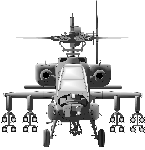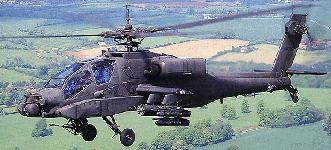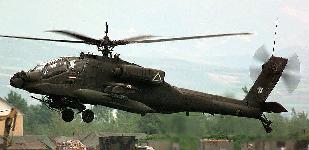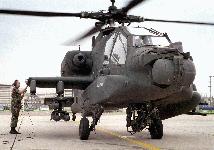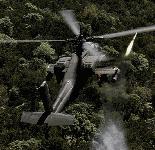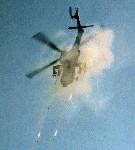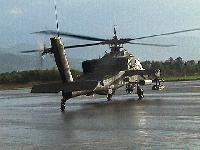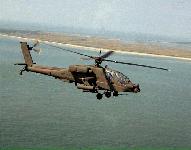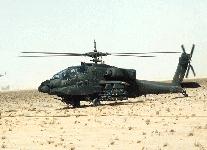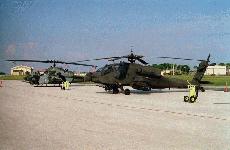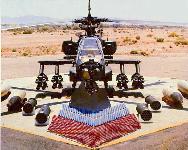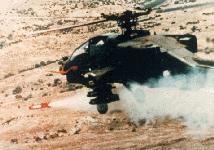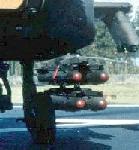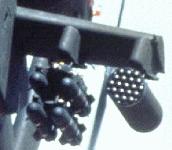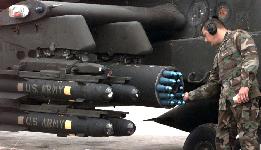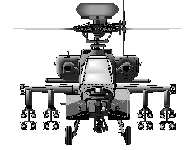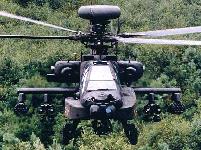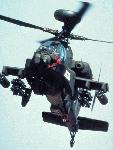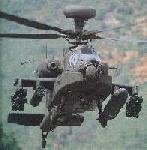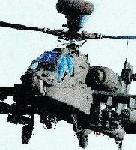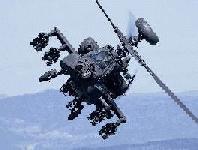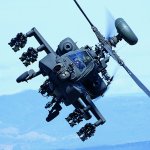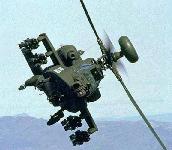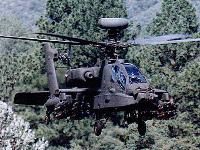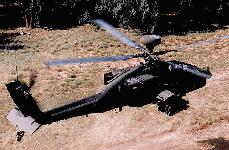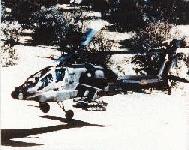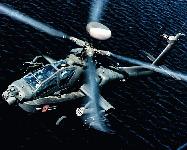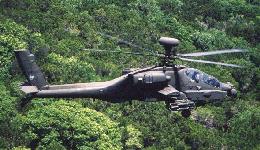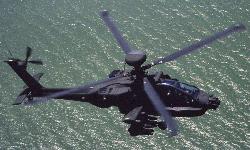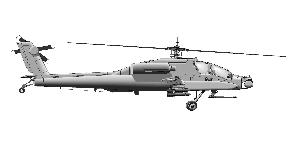




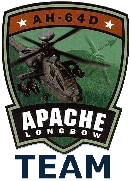 The Boeing (McDonnell Douglas) (formerly Hughes) AH-64A Apache is the Army's primary attack helicopter. It is a quick-reacting, airborne weapon system that can fight close and deep to destroy, disrupt, or delay enemy forces. The Apache is designed to fight and survive during the day, night, and in adverse weather throughout the world. The principal mission of the Apache is the destruction of high-value targets with the HELLFIRE missile. It is also capable of employing a 30MM M230 chain gun and Hydra 70 (2.75 inch) rockets that are lethal against a wide variety of targets. The Apache has a full range of aircraft survivability equipment and has the ability to withstand hits from rounds up to 23MM in critical areas.
The AH-64 Apache is a twin-engine, four bladed, multi-mission attack helicopter designed as a highly stable aerial weapons-delivery platform. It is designed to fight and survive during the day, night, and in adverse weather throughout the world. With a tandem-seated crew consisting of the pilot, located in the rear cockpit position and the co-pilot gunner (CPG), located in the front position, the Apache is self-deployable, highly survivable and delivers a lethal array of battlefield armaments. The Apache features a Target Acquisition Designation Sight (TADS) and a Pilot Night Vision Sensor (PNVS) which enables the crew to navigate and conduct precision attacks in day, night and adverse weather conditions.
The Boeing (McDonnell Douglas) (formerly Hughes) AH-64A Apache is the Army's primary attack helicopter. It is a quick-reacting, airborne weapon system that can fight close and deep to destroy, disrupt, or delay enemy forces. The Apache is designed to fight and survive during the day, night, and in adverse weather throughout the world. The principal mission of the Apache is the destruction of high-value targets with the HELLFIRE missile. It is also capable of employing a 30MM M230 chain gun and Hydra 70 (2.75 inch) rockets that are lethal against a wide variety of targets. The Apache has a full range of aircraft survivability equipment and has the ability to withstand hits from rounds up to 23MM in critical areas.
The AH-64 Apache is a twin-engine, four bladed, multi-mission attack helicopter designed as a highly stable aerial weapons-delivery platform. It is designed to fight and survive during the day, night, and in adverse weather throughout the world. With a tandem-seated crew consisting of the pilot, located in the rear cockpit position and the co-pilot gunner (CPG), located in the front position, the Apache is self-deployable, highly survivable and delivers a lethal array of battlefield armaments. The Apache features a Target Acquisition Designation Sight (TADS) and a Pilot Night Vision Sensor (PNVS) which enables the crew to navigate and conduct precision attacks in day, night and adverse weather conditions.
 The Apache can carry up to 16 Hellfire laser designated missiles. With a range of over 8000 meters, the Hellfire is used primarily for the destruction of tanks, armored vehicles and other hard material targets. The Apache can also deliver 76, 2.75" folding fin aerial rockets for use against
enemy personnel, light armor vehicles and other soft-skinned targets. Rounding out the Apache�s deadly punch are 1,200 rounds of ammunition for its Area Weapons System (AWS), 30MM Automatic Gun. Powered by two General Electric gas turbine engines rated at 1890 shaft horsepower each, the Apache�s maximum gross weight is 17,650 pounds which allows for a cruise airspeed of 145 miles per hour and a flight endurance of over three hours. The AH-64 can be configured with an external 230-gallon fuel tank to extend its range on attack missions, or it can be configured with up to four 230-gallon fuel tanks for ferrying/self-deployment missions. The combat radius of the AH-64 is approximately 150 kilometers. The combat radius with one external 230-gallon fuel tank installed is approximately 300 kilometers [radii are temperature, PA, fuel burn rate and airspeed dependent]. The AH-64 is air transportable in the C-5, C-141 and C-17.
The Apache can carry up to 16 Hellfire laser designated missiles. With a range of over 8000 meters, the Hellfire is used primarily for the destruction of tanks, armored vehicles and other hard material targets. The Apache can also deliver 76, 2.75" folding fin aerial rockets for use against
enemy personnel, light armor vehicles and other soft-skinned targets. Rounding out the Apache�s deadly punch are 1,200 rounds of ammunition for its Area Weapons System (AWS), 30MM Automatic Gun. Powered by two General Electric gas turbine engines rated at 1890 shaft horsepower each, the Apache�s maximum gross weight is 17,650 pounds which allows for a cruise airspeed of 145 miles per hour and a flight endurance of over three hours. The AH-64 can be configured with an external 230-gallon fuel tank to extend its range on attack missions, or it can be configured with up to four 230-gallon fuel tanks for ferrying/self-deployment missions. The combat radius of the AH-64 is approximately 150 kilometers. The combat radius with one external 230-gallon fuel tank installed is approximately 300 kilometers [radii are temperature, PA, fuel burn rate and airspeed dependent]. The AH-64 is air transportable in the C-5, C-141 and C-17.
An on-board video recorder has the capability of recording up to 72 minutes of either the pilot or CPG selected video. It is an invaluable tool for damage assessment and reconnaissance. The Apache's navigation equipment consists of a doppler navigation system, and most aircraft are equipped with a GPS receiver.
The Apache has state of the art optics that provide the capability to select from three different target acquisition sensors. These sensors are
Low cloud ceilings may not allow the Hellfire seeker enough time to lock onto its target or may cause it to break lock after acquisition. At extended ranges, the pilot may have to consider the ceiling to allow time for the seeker to steer the weapon onto the target. Pilot night vision sensor cannot detect wires or other small obstacles.
Overwater operations severely degrade navigation systems not upgraded with embedded GPS. Although fully capable of operating in marginal weather, attack helicopter capabilities are seriously degraded in conditions below a 500-foot ceiling and visibility less than 3 km. Because of the Hellfire missile's trajectory, ceilings below 500 feet require the attack aircraft to get too close to the intended target to avoid missile loss. Below 3 km visibility, the attack aircraft is vulnerable to enemy ADA systems. Some obscurants can prevent the laser energy from reaching the target; they can also hide the target from the incoming munitions seeker. Dust, haze, rain, snow and other particulate matter may limit visibility and affect sensors. The Hellfire remote designating crew may offset a maximum of 60 degrees from the gun to target line and must not position their aircraft within a +30-degree safety fan from the firing aircraft. The Apache fully exploits the vertical dimension of the battlefield. Aggressive terrain flight techniques allow the commander to rapidly place the ATKHB at the decisive place at the optimum time. Typically, the area of operations for Apache is the entire corps or divisional sector. Attack helicopters move across the battlefield at speeds in excess of 3 kilometers per minute. Typical planning airspeeds are 100 to 120 knots during daylight and 80 to 100 knots at night. Speeds during marginal weather are reduced commensurate with prevailing conditions. The Apache can attack targets up to 150 km across the FLOT. If greater depth is required, the addition of ERFS tanks can further extend the AH-64's range with a corresponding reduction in Hellfire missile carrying capacity (four fewer Hellfire missiles for each ERFS tank installed). Apache production began in FY82 and the first unit was deployed in FY86. As of November 1993, 807 Apaches were delivered to the Army. The last Army Apache delivery is scheduled for December 1995. Thirty-three attack battalions are deployed and ready for combat. The Army is procuring a total of 824 Apaches to support a new force structure of 25 battalions with 24 Apaches for each unit (16 Active; 2 Reserve; 7 National Guard) under the Aviation Restructure Initiative. The Apache has been sold to Israel, Egypt, Saudi Arabia, the UAE, and Greece.The Russian-developed Mi-24 HIND is the Apache's closest couterpart. The Russians have deployed significant numbers of HINDs in Europe and have exported the HIND to many third world countries. The Russians have also developed the KA-50 HOKUM as their next generation attack helicopter. The Italian A-129 Mangusta is the nearest NATO counterpart to the Apache. The Germans and French are co-developing the PAH-2 Tiger attack helicopter, which has many of the capabilities of the Apache.
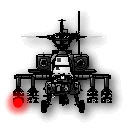 The AH-64 fleet consists of two aircraft models, the AH-64A and the newer Longbow Apache (LBA), AH-64D. AH-64A model full-scale production began in 1983 and now over 800 aircraft have been delivered to the U.S. Army and other NATO Allies. The U.S. Army plans to remanufacture its entire AH-64A Apache fleet to the AH-64D configuration over the next decade. The AH-64A fleet exceeded one million flight hours in 1997, and the median age of today's fleet is 9 years and 1,300 flight hours.
The AH-64A proved its capabilities in action during both Operation Restore Hope and Operation Desert Storm. Apache helicopters played a key role in the 1989 action in Panama, where much of its activity was at night, when the AH-64's advanced sensors and sighting systems were effective against Panamanian government forces.
The AH-64 fleet consists of two aircraft models, the AH-64A and the newer Longbow Apache (LBA), AH-64D. AH-64A model full-scale production began in 1983 and now over 800 aircraft have been delivered to the U.S. Army and other NATO Allies. The U.S. Army plans to remanufacture its entire AH-64A Apache fleet to the AH-64D configuration over the next decade. The AH-64A fleet exceeded one million flight hours in 1997, and the median age of today's fleet is 9 years and 1,300 flight hours.
The AH-64A proved its capabilities in action during both Operation Restore Hope and Operation Desert Storm. Apache helicopters played a key role in the 1989 action in Panama, where much of its activity was at night, when the AH-64's advanced sensors and sighting systems were effective against Panamanian government forces.
Apache helicopters also played a major role in the liberation of Kuwait. On 20 November 1990, the 11th Aviation Brigade was alerted for deployment to Southwest Asia from Storck Barracks in Illesheim Germany. The first elements arrived in theater 24 November 1990. By 15 January 1991 the unit had moved 147 helicopters, 325 vehicles and 1,476 soldiers to the region. The Apache helicopters of the Brigade destroyed more than 245 enemy vehicles with no losses.
During Operation Desert Storm, AH-64s were credited with destroying more than 500 tanks plus hundreds of additional armored personnel carriers, trucks and other vehicles. They also were used to destroy vital early warning radar sites, an action that opened the U.N. coalition's battle plan. Apaches also demonstrated the ability to perform when called upon, logging thousands of combat hours at readiness rates in excess of 85 percent during the Gulf War.
While recovery was ongoing, additional elements of the 11th Aviation Brigade began the next chapter of involvement in the region. On 24 April 1991 the 6th Squadron, 6th Cavalry�s 18 AH-64 helicopters began a self-deployment to Southwest Asia. The Squadron provided aerial security to a 3,000 square kilometer region in Northern Iraq as part of the Combined Task Force of Operation Provide Comfort.And the AH-64A Apache helped to keep the peace in Bosnia. April of 1996 saw the beginning of the 11th Regiment�s involvement in Bosnia-Herzegovina. Elements of 6-6 Cavalry served as a part of Task Force Eagle under 1st Armored Division for 7 months. In October of 1996, Task Force 11, consisting of the Regimental Headquarters, 2-6 Cavalry, 2-1 Aviation and 7-159 Aviation (AVIM) deployed to Bosnia-Herzegovina in support of Operation Joint Endeavor/Operation Joint Guard for 8 months. In June of 1998 the Regimental Headquarters, 6-6 Cav and elements of 5-158 Aviation were again deployed to Bosnia-Herzegovina in support of Operations Joint Guard and Joint Forge for 5 months. The AH-64A’s advanced sensors and sighting systems proved effective in removing the cover of darkness from anti-government forces.
Army National Guard units in North and South Carolina, Florida, Texas, Arizona, Utah and Idaho also fly Apache helicopters. The Army has fielded combat-ready AH-64A units in the United States, West Germany and in Korea, where they play a major role in achieving the US Army's security missions.
By late 1996, McDonnell Douglas Helicopters delivered 937 AH-64A Apaches -- 821 to the U.S. Army and 116 to international customers, including Egypt, Greece, Israel, Saudi Arabia and the United Arab Emirates.
The Apache is clearly one of the most dynamic and important programs in aviation and the Army, but it is not without limitations. Due to the possibility of surging the engines, pilots have been instructed not to fire rockets from in-board stations. According to current doctrine, they are to fire no more than pairs with two outboard launchers every three seconds, or fire with only one outboard launcher installed without restrictions (ripples permitted). These are the only conditions permitted. Other firing conditions will be required to be approved via a System Safety Risk Assessment (SSRA). The improvement of aircraft systems troubleshooting is a high priority issue for O&S Cost reduction. Because of funding cuts, the level of contractor support to the field has been reduced. This results in higher costs in no fault found removals, maintenance man hours, and aircraft down time. The Apache PM, US Army Aviation Logistics School, and Boeing are currently undertaking several initiatives. Upgrading and improving the soldier's ability to quickly and accurately fault isolate the Apache weapons system is and will continue to be an O&S priority until all issues are resolved. Prime Vendor Support (PVS) for the entire fleet of AH-64s is a pilot program for the Army, and may become a pilot program for the Department of Defense. PVS will place virtually all of Apache's wholesale logistic responsibility under a single contract. The Apache flying hour program will provide upfront funding for spares, repairables, contractor technical experts, and reliability improvements. Starting at the flight line there will be contractor expert technicians with advanced troubleshooting capability assigned to each Apache Battalion. At the highest level, PVS represents a single contractor focal point for spares and repairs. The intent is to break the current budget and requirements cycle that has Apache at 67% supply availability with several thousand lines at zero balance. Modernization Through Spares (MTS) is a spares/component improvement strategy applied throughout the acquisition life cycle and is based on technology insertion to enhance systems and extend useful life while reducing costs. The MTS initiative seeks to leverage current procurement funds and modernize individual system spares thereby incrementally improving these systems. MTS is accomplished via the "spares" acquisition process. MTS, a subset of acquisition reform, seeks to improve an end item's spare components. The emphasis is on form, fit and function, allowing a supplier greater design and manufacturing flexibility to exploit technology used in the commercial marketplace. Apache MTS focuses on the insertion of the latest technology into the design and manufacture of select spares. This is to be accomplished without government research and development (R&D) funds, but rather, uses industry investment. Industry, in turn, recoups this investment through the sale of improved hardware via long term contracts. Modernization efforts continue to improve the performance envelope of the AH-64A while reducing the cost of ownership. Major modernization efforts within the AH-64A fleet are funded and on schedule. GG Rotor modifications were finished in April 1998,, and future improvements such as a Second Generation FLIR, a High Frequency Non-Line of Sight NOE radio, and an internal fully crashworthy auxiliary fuel tank are all on the verge of becoming a reality for the Apache. The Aviation Mission Planning System (AMPS) and the Data Transfer Cartridge (DTC) are tools for the Embedded Global Positioning Inertial Navigation Unit (EGI) equipped AH-64A aircraft that allow aircrews to plan missions and download the information to a DTC installed in the Data Transfer Receptacle (DTR). This saves the pilots a lot of "fat fingering" and eliminates the worry of everyone being on the same "sheet of music". Other features of the DTC include; saving waypoints and targets and troubleshooting. The EGI program is a Tri-service program with the Army, Air Force and Navy.

| Primary Mission | Starboard Wing | M230 Gun | Port Wing | Rate of Climb | Duration |
| Combat (Anti-armor) |
4 Hellfire | 320 rds 30mm | 4 Hellfire | 1450 fpm | 1.8 hours |
| Multi-role (Covering force) |
4 Hellfire 19 FFAR * |
1200 rds 30mm | 4 Hellfire 19 FFAR * |
860 fpm | 2.5 hours |
| Close-support (Anti-armor) |
8 Hellfire | 1200 rds 30mm | 8 Hellfire | 990 fpm | 2.5 hours |
| Ground-support (Airmobile escort) |
38 FFAR * | 1200 rds 30mm | 38 FFAR * | 780 fpm | 2.5 hours |

During Army operational testing in 1995, all six Longbow Apache prototypes competed against standard AH-64A Apaches. The threat array developed to test the combat capabilities of the two Apache designs was a postulated 2004 lethal and digitized force consisting of heavy armor, air defense and countermeasures. The tests clearly demonstrated that Longbow Apaches:
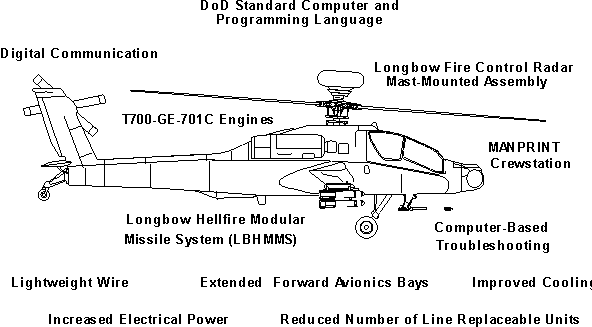
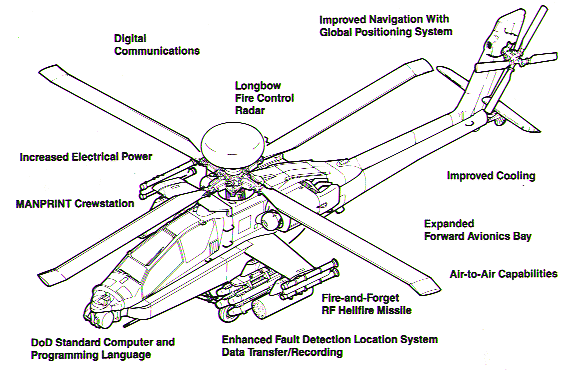
The Longbow RF missile and the Longbow HELLFIRE Launcher (LBHL) are referred to as the LBHMMS. The system incorporates a fire-and-forget missile that accepts primary and/or secondary targeting information from the FCR and single targeting information from TADS or another aircraft to acquire and engage targets. Similar to the FCR, the RF missile provides the capability to engage threats in adverse weather and through battlefield obscurants. Two acquisition modes, lock-on-before-launch (LOBL) and lock-on-after-launch (LOAL), allow engagement of ground and rotary wing threats at extended ranges. In the LOBL mode, the missile will acquire and track moving or short range stationary targets prior to leaving the launch platform. In the LOAL mode, the missile will acquire long range stationary targets shortly after leaving the launch platform.
The combination of the integrated FCR, LBHMMS and the Apache aircraft enhances battlefield awareness by providing coverage of the battle area at extended ranges, by reducing operational dependence on weather and battlefield conditions, and by rapid display of detected targets. It further improves the Longbow system's war fighting capability and survivability by providing rapid multi-target detection and engagement ability, navigational aids, and a fire-and-forget weapon delivery system.
The addition of the Longbow FCR provides a second and completely independent target acquisition sensor which may be operated by either crew member or combined to provide a degree of multi-sensor synergy. When operated independently, the pilot could use the FCR to search for air targets in the ATM mode while the copilot/gunner (CPG) searches for ground targets using the Target Acquisition Designation Sight (TADS).Using both TADS and the FCR together combines the unique advantage of each sight. The rapid search, detection, classification, and prioritization of targets by the Longbow FCR can then be quickly and positively identified by using the electro-optics of TADS. The center of view can be focused on the location of the highest priority target and the CPG, at the touch of a switch, can view either display. Alternately, the FCR centerline can be cued to the TADS so that a rapid and narrow search could be made of a suspected target area.
The RFI is an integral part of the Longbow FCR. It has sensitivity over an RF spectrum to detect threat emitters when a threat radar is in a search and acquisition mode and also when the threat emitter is "looking" directly at and tracking the Longbow system. The RF band has been extended over that which was developed for the OH-58D Kiowa Warrior at the low end of the RF spectrum to detect newly identified air defense threats. The RFI has a programmable threat emitter library to allow additional threat signatures to be stored and/or updated. The Materiel Fielding Plan (MFP) is essentially a one-stop reference for all fielding activity requirements. It shows who develops, fields, receives, and stores a piece of equipment and its associated tools, test equipment, repair parts, and training devices. The MFP will outline what the piece of equipment is used for, who uses it, who repairs it, the maintenance and supply structure which will be in place to provide life cycle support, and the training requirements inherent to the system. Several draft version MFPs are published per the documents listed above in order to generate a dialogue between the developer and the end user in order to simplify and expedite the fielding process. The AH-64D Apache Longbow aircraft, Fire Control Radar (FCR), and Longbow Hellfire Modular Missile System (LBHMMS) were fielded starting with the 1-227 Attack Helicopter Battalion in July 1998. As this is a FORSCOM unit, the first MFP published will be for FORSCOM. Other MFPs, each tailored to the specific Major Command (MACOM) receiving the AH-64D, will be published at the appropriate time. Therefore, FORSCOM, TRADOC, USAREUR, EUSA, USAR, and the ARNG will each receive their own version of the MFP. Distribution varies with each subsequent draft prepared. The Office of the Deputy Chief of Staff for Operations and Plans (ODCSOPS) makes the decision as to what units receive the AH-64D and in what order. The AAH PMO publishes and distributes MFPs based on ODCSOPS' schedule. The fielding schedules change from time to time, and the schedule in the MFP is, therefore, current as of the publishing date. The First Draft for each MACOM's MFP is published approximately 26 months before the first aircraft and equipment are fielded to a MACOM. A MACOM's Final MFP is published approximately 8 months prior to its first-unit fielding. The fielding schedule as of 1 June 1997, is attached. It does not include the aircraft destined for the TRADOC training fleet at Ft. Rucker. Ft. Rucker begins receiving its AH-64Ds in June 1999; the TRADOC First Draft MFP left the AAH PMO in May.| FIELDING | UNIT LOCATION | STAGE AT 21ST CAV | E-DATE | COLLECTIVE TRAINING | MISSION READY |
|---|---|---|---|---|---|
| 1 | 1-227 AVN | HOOD | FEB-APR 98 | JUL 98 JUL-SEP 98 | OCT 98 |
| 2 | 2-101 AVN | CAMPBELL | FEB-APR 99 | JUN 99 JUN-AUG 99 | SEP 99 |
| 3 | 1-2 AVN | KOREA | SEP-NOV 99 | JUN 00 JUN-AUG 00 | SEP 00 |
| 4 | 1-101 AVN | CAMPBELL | FEB-APR 00 | NOV 00 DEC 00- FEB 01 | MAR 01 |
| 5 | 1-3 AVN | STEWART | JUN-AUG 00 | MAR 01 MAR-MAY 01 | JUN 01 |
| 6 | 6-6 CAV | GERMANY | JAN-MAR 01 | AUG 01 AUG-OCT 01 | NOV 01 |
| 7 | 3-101 AVN | CAMPBELL | JUN-AUG 01 | MAR 02 MAR-MAY 02 | JUN 02 |
| 8 | 4-3 ACR | CARSON | JAN-APR 02 | JUN 02 JUN-AUG 02 | SEP 02 |
| 9 | 1-501 AVN | GERMANY | JAN-MAR 02 | NOV 02 NOV 02-JAN 03 | FEB 03 |
| 10 | 1-229 AVN | BRAGG | JUL-SEP 02 | APR 03 APR-JUN 03 | JUL 03 |
| 11 | 3-6 CAV | KOREA | NOV-DEC 02 | AUG 03 AUG-OCT 03 | NOV 03 |
| 12 | 3-229 AVN | BRAGG | APR-JUN 03 | FEB 04 FEB-APR 04 | MAY 04 |
| 13 | 1-1 AVN | GERMANY | SEP-NOV 03 | JUL 04 JUL-SEP 04 | OCT 04 |
| 14 | 1-111 AVN | FLNG | MAR-JUL 04* | NOV 04 NOV O4-JAN 05 | FEB 05 |
| 15 | 1-6 CAV | KOREA | MAY-JUL 04 | MAR 05 MAR-MAY 05 | JUN 05 |
| 16 | 1-130 AVN | NCNG | NOV 04-MAY 05* | AUG 05 AUG-OCT 05 | NOV 05 |
| 17 | 2-6 CAV | GERMANY | FEB-APR 05 | DEC 05 JAN-MAR 05 | APR 06 |
| 18 | 1-4 AVN | HOOD | OCT-DEC 05 | APR 06 APR-JUN 06 | JUL 06 |
| 19 | 8-229AVN | KYAR | APR-AUG 06* | SEP 06 SEP-NOV 06 | DEC 06 |
| 20 | 1-151 AVN | SCNG | AUG-DEC 06* | JAN 07 JAN-MAR 07 | APR 07 |
| 21 | 7-6 CAV | TXAR | JAN-APR 07* | MAY 07 MAY-JUL 07 | AUG 07 |
| 22 | 1-285 AVN | AZNG | APR-JUL 07* | OCT 07 OCT-DEC 07 | JAN 08 |
| 23 | 1-183 AVN | IDNG | JUL-OCT 07* | FEB 08 FEB-APR 08 | MAY 08 |
| 24 | 1-211 AVN | UTNG | OCT 07-JAN 08* | JUN 08 JUN-AUG 08 | SEP 08 |
| 25 | 1-149 AVN | TXNG | JAN-APR 08 | NOV 08 NOV 08-JAN 09 | FEB 09 |
Specifications | ||
| Contractors | Boeing McDonnell Douglas Helicopter Systems(Mesa, AZ) General Electric (Lynn, MA) Martin Marietta (Orlando, FL) | |
| Propulsion | Two T700-GE-701Cs | |
| Crew | Two | |
| AH-64A | AH-64D | |
| Length | 58.17 ft (17.73 m) | 58.17 ft (17.73 m) |
| Height | 15.24 ft (4.64 m) | 13.30 ft (4.05 m) |
| Wing Span | 17.15 ft (5.227 m) | 17.15 ft (5.227 m) |
| Primary Mission Gross Weight | 15,075 lb (6838 kg) 11,800 pounds Empty | 16,027 lb (7270 kg) Lot 1 Weight |
| Hover In-Ground Effect (MRP) |
15,895 ft (4845 m) [Standard Day] 14,845 ft (4525 m) [Hot Day ISA + 15C] |
14,650 ft (4465 m) [Standard Day] 13,350 ft (4068 m) [Hot Day ISA + 15 C] |
| Hover Out-of-Ground Effect (MRP) |
12,685 ft (3866 m) [Sea Level Standard Day] 11,215 ft (3418 m) [Hot Day 2000 ft 70 F (21 C)] |
10,520 ft (3206 m) [Standard Day] 9,050 ft (2759 m) [Hot Day ISA + 15 C] |
| Vertical Rate of Climb (MRP) |
2,175 fpm (663 mpm) [Sea Level Standard Day] 2,050 fpm (625 mpm) [Hot Day 2000 ft 70 F (21 C)] |
1,775 fpm (541 mpm) [Sea Level Standard Day] 1,595 fpm (486 mpm) [Hot Day 2000 ft 70 F (21 C)] |
| Maximum Rate of Climb (IRP) |
2,915 fpm (889 mpm) [Sea Level Standard Day] 2,890 fpm (881 mpm) [Hot Day 2000 ft 70 F (21 C)] |
2,635 fpm (803 mpm) [Sea Level Standard Day] 2,600 fpm (793 mpm) [Hot Day 2000 ft 70 F (21 C)] |
| Maximum Level Flight Speed |
150 kt (279 kph) [Sea Level Standard Day] 153 kt (284 kph) [Hot Day 2000 ft 70 F (21 C)] |
147 kt (273 kph) [Sea Level Standard Day] 149 kt (276 kph) [Hot Day 2000 ft 70 F (21 C)] |
| Cruise Speed (MCP) |
150 kt (279 kph) [Sea Level Standard Day] 153 kt (284 kph) [Hot Day 2000 ft 70 F (21 C)] |
147 kt (273 kph) [Sea Level Standard Day] 149 kt (276 kph) [Hot Day 2000 ft 70 F (21 C)] |
| Range | 400 km - internal fuel 1,900 km - internal and external fuel | |
| Armament |
M230 33mm Gun 70mm (2.75 inch) Hydra-70 Folding-Fin Aerial Rockets AGM-114 Hellfire anti-tank missiles AGM-122 Sidearm anti-radar missile AIM-9 Sidewinder Air-to-Air missiles 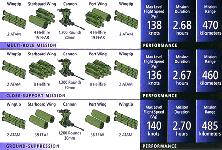
| |
| Mission Equipment |
Target Acquisition and Designation System / Pilot Night Vision System | |
| Reliability | The general objective of aircraft readiness is to achieve 75% Mission Capable. | |
| Costs |
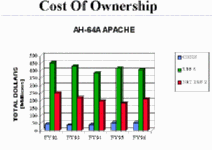
| |
